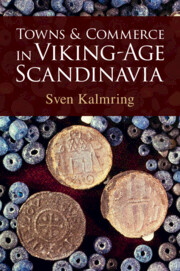Book contents
- Towns and Commerce in Viking-Age Scandinavia
- Additional material
- Towns and Commerce in Viking-Age Scandinavia
- Copyright page
- Epigraph
- Contents
- Plates
- Figures
- Maps
- Acknowledgements
- Abbreviations
- Maps
- 1 Introduction
- 2 The Viking-Age Town
- 3 The Viking World
- 4 Cult, Jurisdiction and Markets
- 5 Local Society and Viking-Age Towns
- 6 An Urbanisation Based on Harbours
- 7 Jurisdiction and Taxes
- 8 Free Trade within Narrow Boundaries
- 9 Special Economic Zones of Their Time
- 10 Development after the Inception Phase
- 11 Discussion: Hedeby’s Abandonment and the Foundation of Slesvig
- 12 Summary and Conclusions
- References
- Index
- Plate Section
1 - Introduction
Published online by Cambridge University Press: 04 January 2024
- Towns and Commerce in Viking-Age Scandinavia
- Additional material
- Towns and Commerce in Viking-Age Scandinavia
- Copyright page
- Epigraph
- Contents
- Plates
- Figures
- Maps
- Acknowledgements
- Abbreviations
- Maps
- 1 Introduction
- 2 The Viking-Age Town
- 3 The Viking World
- 4 Cult, Jurisdiction and Markets
- 5 Local Society and Viking-Age Towns
- 6 An Urbanisation Based on Harbours
- 7 Jurisdiction and Taxes
- 8 Free Trade within Narrow Boundaries
- 9 Special Economic Zones of Their Time
- 10 Development after the Inception Phase
- 11 Discussion: Hedeby’s Abandonment and the Foundation of Slesvig
- 12 Summary and Conclusions
- References
- Index
- Plate Section
Summary
The Viking Age – traditionally framed by the historic raid on the monastery at Lindisfarne in Northumbria in 793 and the battles of Stamford Bridge and Hastings in 1066, and nowadays archaeologically set to c.750–1050 – was an era of major societal changes in Scandinavia that has fascinated generations of scholars and laypeople. This sweepingly transformative period led to the integration of this formerly pagan periphery of the European North into occidental Europe, as these societies became unified Christian kingdoms. One of the most central fields to Viking-age archaeology – alongside research problems relating to the Christianisation of Scandinavia and the intertwined processes of state formation, or more specifically the development ‘From Tribe to State’ (Mortensen & Rasmussen 1991) – is the initial and unprecedented dawn of urbanisation in Scandinavia, which was distinctly different from the archetypes of ancient towns of the former Roman Empire. As novel centres of trade and crafts, these emerging Viking-age towns were inseparably linked to the spheres of economy, maritime connectivity, and patronage.
- Type
- Chapter
- Information
- Towns and Commerce in Viking-Age Scandinavia , pp. 1 - 6Publisher: Cambridge University PressPrint publication year: 2024

